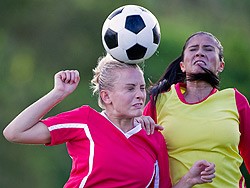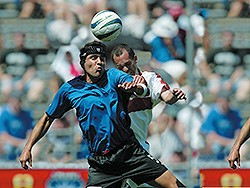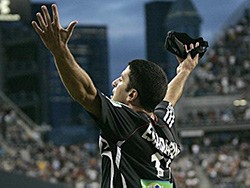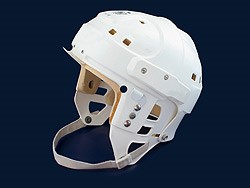Laird Harrison
May 09, 2017
Head Injuries Too Common in Female Athletes
A competitive 16-year-old soccer player, Lauren Skeen was leaping for a
head ball when her head cracked into the head of an opposing player. It
was her second such collision, and this time she fell into a grand mal seizure.
 Such head injuries are all too common in the world's most popular sport,
particularly for girls. Girls playing soccer suffer 9 concussions per
10,000 games or practices the same incidence as boys playing American
football in US high schools,
researchers at Northwestern University in Chicago have found. And since many concussions go unrecognized, the actual incidence could
be much higher;
as many as half of all players report symptoms.[1]
Such head injuries are all too common in the world's most popular sport,
particularly for girls. Girls playing soccer suffer 9 concussions per
10,000 games or practices the same incidence as boys playing American
football in US high schools,
researchers at Northwestern University in Chicago have found. And since many concussions go unrecognized, the actual incidence could
be much higher;
as many as half of all players report symptoms.[1]
The US Soccer Federation and Major League Soccer have responded to the problem, primarily with initiatives to reduce the amount of heading done by children under age 14, and to remove players with concussions from games.
An international consensus statement on sports-related concussions, published April 26 in the British Journal of Sports Medicine, offers scant guidance for prevention in soccer.
A Father's Battle for Protection
To Lauren Skeen's father, Jeff Skeen, the current recommendations fall far short of what's necessary to protect soccer players. After Lauren's second concussion in 2001, Jeff (a former employee of Troxel, maker of equestrian helmets) put together a broad padded headband he thought would protect his daughter during soccer.
But when Lauren's team made it to the quarter finals of the California championship a year later, the referee told her to take it off. Once again, Lauren's head collided with another girl's head. This time, Lauren suffered such severe disorientation that her parents had to give her wristbands to tell her where she should be. Recovery took 6 months. "The soccer community just pissed off the wrong person," Jeff Skeen said.
The Fédération Internationale de Football Association (FIFA), the international organization that oversees the US Soccer Federation, no longer prevents players from using the headgear, and some professionals now use them. But Skeen, who went on to found the Full90 soccer headgear company, is still battling to force the organization to endorse some sort of head protection—or to come up with a better solution.
Removing concussed players from games may reduce the harm to those players caused by further blows or exertion, but it won't reduce the number of new concussions, Skeen argues. "There is not a single thing that is being done to eliminate a single concussion other than our headgear," he says.
A Plea for Clinical Trials of Headgear
Faced with a high incidence of anterior cruciate ligament (ACL) tears, which also disproportionately affect teenage girls, FIFA supported randomized controlled trials of a series of strengthening and balancing exercises. The exercises, branded FIFA 11+, were shown to significantly reduce the risk for this type of injury.[2]
Skeen and others would like to see FIFA support a similar randomized clinical trial of headgear. But officials say there just isn't enough preliminary evidence to warrant such an exploration. "In the lab, they haven't found any great success in terms of reducing concussive forces in this way," says Bert Mandelbaum, MD, a Santa Monica, California, orthopedist and assistant medical director of Major League Soccer.

Image courtesy of Full90 Sports
In fact, studies so far support the use of headgear to prevent concussions. Some confusion stems from the unique way that players' heads are used in soccer. Intentional heading itself rarely causes concussions because the ball absorbs most of the energy from the collision.
Only about 8% of concussions in men and 18.3% in women result from contact with the ball, and most of these appear to be from unintentional contact, such as when a ball from one field hits a player on another field from behind.[3,4]
In one experiment, FIFA researchers shot balls from a mechanical launcher at a subject holding accelerometers in his mouth, and found that headgear made little difference to the movements of his head.[5] Nevertheless, some researchers have worried that repetitive subconcussive blows might cause cumulative trauma. An average player heads the ball 6-12 times per game and performs at least 2000 headers during a 20-year career in addition to repetitive heading drills at training.[4]
Efforts to discern neurologic effects from this have produced contradictory results.[4] Researchers examining retired professional soccer players have calculated increased rates of dementia, possibly due to chronic traumatic encephalopathy like that suffered by many American football players. But modern soccer balls, made of synthetic material, are lighter than the leather ones the retired players may have used throughout most of their careers. And the brain damage in these players could have resulted from contact with other hard objects, such as opponents' heads, rather than with the ball.[3]
Protection for Head and Hard Surface Collisions
If intentional heading does cause damage, headgear doesn't seem likely to protect against it. Researchers have suggested that headgear causes a change in the radius of the head, which increases both the ball's moment arm and the head's moment of inertia.[6] That could explain why one study showed that volunteers who headed a soccer ball 15 times in 15 minutes suffered small but significant short-term memory losses if they wore headgear, but not if their heads were bare.[5]
 Image courtesy of Full90 Sports
Image courtesy of Full90 Sports
While he believes that heading is likely to cause cumulative damage, Skeen says he didn't design his headgear to protect against head-to-ball contact because that would change the way the game is played. "We're trying to make the headgear ignore the head-to-ball impact, because if you reduce the impact you would slow the rebound speed or direction of the ball," he says.
Instead, Skeen designed Full90 gear to protect against collisions between the head and other hard surfaces, such as another head, an elbow, a goal post, or the ground. As many as 80% of soccer concussions result from player-to-player collisions, such as "heading duels" of the type that proved so harmful to Lauren Skeen.[4]
It's common sense that putting something between a head and another hard surface—such as another head, an elbow, a goal post, or the ground—will protect the head. FIFA required players to wear shin guards in 1990 based on little more than such intuitive reasoning.[7]
And a handful of laboratory and observational studies support the idea. In one study, FIFA researchers outfitted crash test dummy heads with various types of soccer headgear. Earlier studies had showed that soccer players' heads sometimes collide at speeds up to 2.5 m/s. So the researchers dropped one dummy head against another at approximately that speed. They found that the headgear reduced peak linear acceleration by about a third.[6]
On the basis of this and on angular acceleration, they calculated that the best of the headgear significantly reduced the risk for concussion from head-to-head contact. At 3 m/s, the risk was 10% without headgear and 5% with headgear. At 4 m/s, it was 56% with and 7% without.[6]
At least one study of headgear used in actual games suggests that head protection could make a difference. Researchers from McGill University in Montreal collected 278 surveys from soccer players aged 12-17 years. The surveys ask about concussion symptoms and headgear use. Fifty-two wore headgear and 216 did not.[1]
The researchers found that 47.8% had experienced symptoms of a concussion during the 2006 soccer season, although only 15% realized that their symptoms fit the definition of a concussion. Among those who wore headgear, 26.9% had experienced the symptoms, compared with 52.8% of those who did not wear headgear.[1]
The study was retrospective, so it could not control for all variables. For example, it's possible that the players who wore headgear were also more cautious to avoid contact with other players. Also, few of the concussions were diagnosed at the time that they occurred.
But Jeff Skeen finally may get the randomized controlled trial he's been wanting. Researchers from the University of Madison in Madison, Wisconsin, have provided headgear to randomly selected high school soccer teams. The study will include 3000 players and is funded with $300,000 from the National Operating Committee on Standards for Athletic Equipment, which collects licensing fees on sports equipment sold with its certification.
Will Protective Gear Lead to More Injuries?
Even if a more authoritative study such as this shows strong benefits for headgear, Dr Mandelbaum says FIFA authorities have other reservations. "They have learned a few of the lessons that have come from hockey, where they have seen concussions go up," he says. "All of a sudden the helmet becomes part of the weaponry."
 But introducing protective equipment doesn't necessarily lead to unsafe
behavior, including in hockey. For a prospective study, some hockey players
wore full-face shields and others partial face shields. The incidence
of concussions was higher in the players wearing partial guards.[8]
But introducing protective equipment doesn't necessarily lead to unsafe
behavior, including in hockey. For a prospective study, some hockey players
wore full-face shields and others partial face shields. The incidence
of concussions was higher in the players wearing partial guards.[8]
Jeff Skeen thinks that FIFA is resisting headgear because it wants to preserve the sport's reputation as safe and affordable. "They don't want the proliferation of gear," he says. "And they don't want the discussion about whether any danger could reduce participation."
Wellington Hsu, MD, a professor of orthopedic surgery who led the Northwestern University study, is also skeptical of the research so far on headgear in soccer. He doesn't think organized soccer can ignore the problem of concussions. "I think some intervention is required because of the number that we're seeing in our study," he says.
A variety of alternatives have been proposed. The finding that girls are more likely to suffer from concussions than boys leads Dr Hsu to speculate that neck-strengthening exercises might help.
The new international consensus statement supports"rule enforcement of red cards for high elbows in heading duels in professional soccer." In a more radical approach, researchers at Cincinnati Children's Hospital Medical Center have proposed a collar that constricts the jugular just enough to increase the volume of blood in the cranium and reduce the amount the brain can slosh. While imaging studies show protective effects on the brain, the collar has not yet been shown to reduce actual concussions.
For his part, Skeen plans to keep pushing his headgear. It's not about making money, he says. He has lost money on every unit sold for the past 15 years and will gladly get out of the business if Nike or Adidas takes his place. "I just think that the number of head injuries needs to be reduced or the sport will die."
